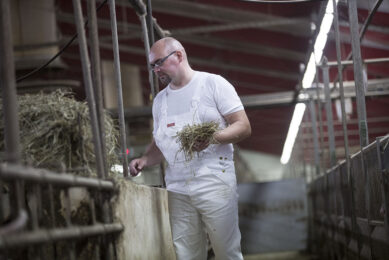What makes a good pig manager?

How do well-known and successful managers, both in pig farming and of the high street retailing chains, approach their different management tasks? In fact, they turn out to be very similar in how they manage their businesses. Here’s the summarising result of ten interviews from experienced persons from both sides.
By John Gadd
During 2007-2008 I carried out two very interesting private surveys. In the first one I interviewed six pig farm managers who were responsible for between 1,100 and 8,000 sows in four countries. These were men who had impressed me when I had met them before or whom I had heard described as first-class and successful pig managers. I wanted to know how they worked and what their priorities were.
This gave me an idea for a second series of interviews, this time visiting the CEOs of four high street retailers whose firms had given me personally good service – not only were their products good value but they were efficient and a real pleasure to deal with. I was interested to see how their views on retail management compared to that of the expert farm managers I had interviewed in the months before.
All interviewees agreed to cooperate on the pretext of staying anonymous. The interviews were held in the UK, Ireland and Denmark.
1. Farm managers’ priorities
Here is a summary from valuable experts with highly practical pig-based experience – an overview of what farm managers should be doing, according to themselves.
Planning well
Both pig flow and work flow need to be planned. Both are of equal importance and it takes at least two hours a day to monitor progress in both of these areas alone. Necessary readjustments should be made on a daily basis, as things can go adrift in a matter of days.
Monitoring
Progress records and measuring equipment especially need to be tracked. Farm managers admitted that scrutinising records took up far too much of their time.
They insisted on checking the measuring instruments themselves (temperature, ventilation, on-farm feed milling and liquid/ pipeline feeding in particular) even though this was usually a primary task of the section heads. “Don’t leave too much to the section heads – the older ones especially can get set in their ways and they too need periodic supervision.”
Buying and selling
All farm managers interviewed said that regular dialogues with both those they bought from and those to whom they sold the finished pigs were essential. Two had been on courses for improving negotiating skills.
Motivating staff
Very interesting – which I’ll expand on below.
Training
Finding time to keep themselves within the technology loop is vital. The authorities stress how important it is to train farm staff properly and the managers admitted that concentrating on this essential task deflected them away from training themselves. I agree – for 20 years I have spent 8% of my income on being trained by others – which shows how fast farm technology is progressing. The more I know about my job – pig production – the more I realise I don’t know.
Enthusiasm for pigs
Not necessarily – the farm managers I spoke to were more interested in business management. This did surprise me at first. Those with this priority in mind had experienced practical pig managers by their side to supervise the daily running of the business. This allowed the senior manager more time to buy, sell and keep abreast of commercial movements in the pig industry – such as hedging and forward buying.
2. Retail managers’ priorities
What follows are the opinions of two national retailers bosses (one a supermarket chain) and two high street firms, but not in priority order. Nearly all these points can be applied to a good farm manager.
Keeping a tight eye on sales
This should be a focus for half of each day at least. Whether farm managers need to allocate so much time to this as the retail trade does is doubtful, but the subject is important and I touch on it below.
Having a good PA
“A first-class personal assistant (PA) provides the information I might need ready and waiting before I need it,” one CEO said. A good accounts/records compiler on the farm called in on a part-time basis to do this work is a similar key assistant for a farm manager. Farm managers do too much paperwork, and a specialist part-timer called in as often as necessary to compile the data on which the manager needs to make decisions is money very well spent.
When discussing this with medium sized pig producers, with say 300-500 sows, many of them said that the size of their business did not merit this investment. I have to disagree. The better producers in this category, whom I know, all have a dedicated part-timer to lift this work off their shoulders. This includes the complicated and time consuming bureaucratic form-filling burden which busy farmers have to suffer these days.
Good negotiating skills
Necessary for both inside – staff, and outside the company – suppliers. It is significant that both top managers in the retail and farming sectors said exactly the same thing. They stressed that buying, along with staff recruitment, training and motivation is the most important area needing daily research and attention. Retail managers have buyers to do the purchasing for them, while farmers invariably have to do their own.
Keeping suppliers in the loop
“An essential part of successful negotiation and it costs nothing but a little time and trouble,” some of the retail managers said. Also, “If my supplier knows me it is easier to get a better deal/ be forewarned of limited supplies.” Another CEO told me, “If any of your staff have to buy-in supplies regularly it is essential that they attend a ‘Negotiating Skills’ course.”
Agricultural colleges need to offer such interesting courses for both those owners and managers who do the buying – interesting, because they cover psychology and human behaviour/reactions. Bigger retailers, especially in the food sector, know that farmers tend to be individualists and thus are easier purchasing targets than when organised into marketing/selling groups – as has long been the case in France and Denmark.
Training staff
The retail managers said, “People make or break businesses.” Another comment was, “While we take great pains to train my ‘front-of-house’ staff (those dealing directly with the public), on how to come across as caring people, this is wasted if people running the logistical (delivery, stocktaking, re-ordering, warehousing) side of the firm are not trained to be super-efficient (and be rewarded for it) for meticulous stock control and in despatching the goods accurately and promptly.”
To a certain extent while only part of this dedication to staff efficiency is applicable to pig producers, I came away impressed by how much importance these top executives regarded the people they had recruited.
Farmers the world over complain that they can’t get good ‘labour’. Even the use of that word shows an outdated attitude, I was told. “Your farmer clients should consider them as people – as individuals – not ‘labour’. Wrong mind-set!”
Getting the right people
“Are farmers recruiting in the right way? Starting really early from school, young farmers should be made enthusiastic about an outdoor life, or indoors as so much agricultural staff work is these days, ‘caring for’ (not just looking after) animals. But they should also be transmitting the idea of having the opportunity to continue to use computers and develop engineering skills and to plan job progression. They need to be shown you care about their own welfare just as much as the animal’s. In failing to do this, farmers ignore motivation and motivation retains good staff. Stress the positive side of your great industry – at the moment we are getting the cream of employees and beating you to it.”
I thought I knew a lot about recruitment and training, having done a lot of it in my time, but I came away from these interviews realising firstly, how far farmers lag behind these retail bosses in this ‘people’ area. Secondly, I ruefully realised that these were the very ‘townees’ we consider know little about our farming way of life, but in the recruitment and training area they seemed to know rather too much about what we are not doing.
Taking the trouble to remember people’s names
“Ask after their families and welfare.”
Always having an open door
Several retail bosses mentioned this, one of them called it “an essential finger on the pulse enabling me to nip trouble – people trouble or product trouble – in the bud.” A suggestions/complaints box is also a very good idea.
Making staff always go more than halfway
Most farm employees don’t have to deal with the farm’s customers – this is the manager’s job. Managers need negotiating skills both in buying and selling – such as using the ‘If I agree to that – will you do this in return?’ approach and other tricks in obtaining a satisfactory deal.
3. Some proper advice
So there in a nutshell we have invaluable advice from successful managers in two very different areas – but pretty similar in content.
Two pig managers who had over 100 staff to motivate and supervise mentioned how important it was to make time to handle people, which I find is lacking on the smaller, say 300 to 500 sow farm. This is because the manager has – or feels he has – too much to do, some of it involving manual work. Sure, when I was managing a pig farm I too found this a relaxing alternative to brain and paperwork, not to mention the telephone (today the computer). It was a relief from the stress and responsibility of managing to go out for a while and get my hands dirty. But I see so many managers thinking they have to assist/get involved in a disproportionate amount of physical work otherwise the work-flow gets behind.
‘Tailchasing’ is the bugbear of our livestock industry at both stockperson and manager level. So how much ‘work’, how much ‘thinking’ should the farm manager do on the average medium-sized farm? In this case a pig farm. My suggestion for consideration is that a manager of a 300-500 sow farrow-to-finish unit should spend at least 35 to 40 hours/week on non-manual management tasks.
He needs to:
• Look at every pen of pigs once a day – two hours/day, plus 30 minutes/day to check on equipment and measuring instruments like thermometers and controllers.
• Brief all staff formally each day – 15-20 minutes. Have a ‘Where are we at?’ discussion session with everybody once a month.
• Plan for, and check on, pig flow against target – 2 hours/week.
• Monitor performance (1): Firstly, from the records, using the computer’s predictive ‘what-if’ facility – grossly underused by managers in this computer age. Every farm over 300 sows should have a part-time person dedicated to keeping the records the manager requires to meet performance and income targets. Managers do too much of this number-crunching themselves which soon gets them stale – as it did me. They do this because they don’t trust anyone else to do this important collating task and the stockpeople don’t like doing it anyway. Remember how vitally those top retail managers regarded their PAs to provide them with essential facts on which they could take the right decisions? 2 hours/week spent on interpreting the numbers – not having to add them up! Then printing-off weekly against-target graphs so as to motivate the staff. That is good management!
• Monitor performance (2) of measuring equipment on the farm, as mentioned above. Most farms haven’t enough monitoring devices available anyway. 30 minutes/day to check and calibrate all your measuring instruments.
• Buying and selling. Regular telephone and personal contact (using the computer to scrutinise and confirm things, not so much dialogue). One hour/day – at least.
• Seeking advice/information-exchange, i.e. with the vet, the nutritionist in charge of ration design, other farm managers, with salespersons (always give time to these ‘nuisances’ but strictly limit them to ten minutes – no more, as they can be good sources of what is going on locally). One hour/day.
• In this day and age – the bugbear of form-filling and bureaucracy. Very variable between industries but in my country it takes a minimum of half an hour a day just to keep up with the authorities and the law. Dreadful – and it is getting worse!
• Finally… allow yourself an hour a day for emergencies, accidents and – to use the vernacular – ‘cock-ups’ which need your urgent attention/decisions.
The livestock magazines haven’t yet told you much of this – have they?
Source: Pig Progress Volume 25 nr 2











